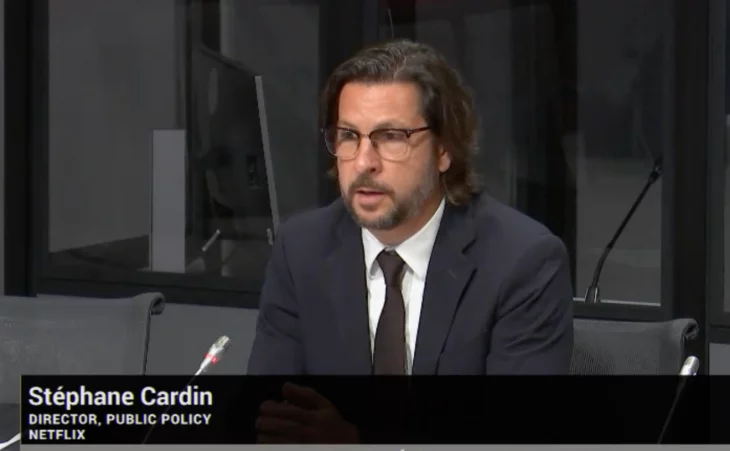
By Howard Law
DESPITE THE SENATE’S singular focus on Bill C-11’s regulation of user generated content, today’s witnesses shed some light on other issues both important and neglected.
The biggest issue that has been mostly avoided in both the House and the Senate is what the post C-11 broadcasting world will look like when the US streamer/studios are placed under new obligations to make and/or finance CanCon, known in CRTC lingo as “Canadian Programming Expenditures (CPE).”
Debate over that issue immediately invokes a hot button issue: what counts as a certified “Canadian” program?
And debate over what is a Canadian program immediately poses a further question: should the current rule requiring Canadian ownership of the production’s intellectual property — second seasons and spin-offs but also the exploitation of a production’s global distribution — remain a sine qua non requirement?
Netflix, Disney+, Paramount+ and Amazon Prime are not Canadian, of course. So the question is how under C-11 will they make Canadian programs in fulfillment of a CPE target handed to them by the CRTC? It’s hardly a secret they will prefer making their own “Canadian” productions rather than writing cheques to a Canadian film fund to finance someone else’s movies.
When a Senator asked Netflix spokesperson Stéphane Cardin (above) today what his priority amendment was, he answered bluntly “copyright,” meaning Netflix should retain full intellectual property rights and be able to certify any movie it makes that otherwise qualifies as Canadian content.
Wendy Noss appearing for the US streamer/studios in Canada (including Netflix, Amazon and Disney+) proposed an amendment stating that “no one factor is determinative” in defining a Canadian program, a swipe at current rules around employment of Canadians in key talent positions but mostly at the inviolable rule on copyright ownership.
This amendment responds to Heritage Minister Pablo Rodriguez’s statement in May that he contemplates a post C-11 government directive to the CRTC to review the long standing CanCon certification rules, although it’s far from certain he had copyright in mind.
The intention of the streamer/studios’ amendment is best understood in the context of existing “CAVCO” rules governing a producer’s claim to “CanCon” production tax credits under the Income Tax Act that are in turn linked to the CRTC’s parallel set of rules governing certification of broadcasted Canadian programs (CPE).
Both the CAVCO and CRTC rules determine Canadian content exclusively by a point system that tallies the employment of Canadians in key creative roles. Going a step further, the CAVCO tax rules require the producer to be a Canadian who retains copyright. The CRTC broadcasting rules are not quite as specific about Canadian copyright ownership and up until now that was unimportant because only Canadian-owned broadcasters are regulated by the CRTC, not American streamers/studios.
Here’s the realpolitik that few are saying out loud: if the US streamer/studios are regulated in Canada without the opportunity to retain global distribution rights to their movies, we are going to see a CUSMA trade complaint regardless of its merits.
The Canadian film industry is equally adamant about copyright 180 degrees in the other direction.
It is not just Canadian movie makers jealously guarding the Canada Media Fund’s $366 million kitty for certified Canadian films (although that matters of course).
It is not just questioning why big American streamer/studios should be permitted to access CanCon tax credits financed by Canadian taxpayers.
It’s instead the concern that unless independent Canadian producers retain full rights to exploit and profit from their best creations (including distribution to global audiences), they will become CanCon sub-contractors in their own land as US streamer/studios insist that Canadian independents surrender copyright and global profits in exchange for distribution on their global platforms.
As both of today’s “Canadian” witnesses (Blue Ant Media and the Canadian Association of Film Distributors and Exporters) stated, without copyright Canadian producers will become the “hewers of wood and drawers of water” of old.
There’s merit to both sides of the argument in an asymmetric way, meaning a win-win compromise is not out of the question. The streamer/studios’ amendment is probably a non-starter for the Liberals, Bloc and the NDP. But perhaps the CRTC — with a gentle nudge from the minister in a policy directive — will look at it this way:
The US streamer/studios regulated by C-11 are likely to make the kind of big budget CanCon movies (with global audience appeal being the key) that just don’t get financed in Canada.
The CRTC could establish a high threshold for production budgets above which it could certify a film for Canadian content if the streamer/studio shares the copyright and exploitation rights 50/50 with a Canadian producer or broadcaster.
Any production below that threshold — essentially the production budgets of current Canadian movies— would still require 100% Canadian ownership and retention of intellectual property.
Now that might seem like apostasy to some (and no less irksome to Netflix and Disney+) but would the Canadian industry and Canadians be better or worse off?
This is a post about C-11 hearings so there is no escaping the discoverability issue.
Today the Senate heard from its umpteenth YouTuber witness. But in a refreshing development, Bastien Forrest wanted to talk about how C-11 fails to address how we could nurture Canadian digital first creators by earmarking a portion of YouTube’s CanCon contribution for Canadian creators.
Similar to the pitch made by Andrew Cash on behalf of Canadian independent music companies on September 21, Forrest argued that the shortest line between the two points of creation and consumption of online Canadian content is subsidizing supply.
Forrest spent four and a half minutes of his five minute Senate presentation making his point, adding at the last moment his agreement with other YouTubers about the perils of interfering with YouTube’s distribution algorithm.
Unfortunately during questioning Senators ignored Forrest’s main point and obsessed about the latter.
This is consistent with the long shot political strategy devised by Digital First Canada who, in an alliance with the Conservatives, insist upon a total exclusion of regulating user generated programs. Meanwhile a consensus Senate amendment to limit its regulatory scope, or directly help digital first creators, might find favour with a majority of MPs in the House of Commons.
A C-11 issue concerning labour rights surfaced on September 14 when ACTRA appeared before the Senate and it doesn’t reflect well on a Liberal government that has no desire to appear to be anti-union.
Back on June 14 the Liberal, NDP and Bloc MPs on the Commons Heritage Committee broke through the Conservative filibuster and passed 42 amendments in one all-nighter session. Most of the amendments had been publicly tabled and debated by MPs during previous hearings but many had not and were pushed through unceremoniously following ex-camera negotiations among MPs.
One of these secret amendments sought by the US streamers was tabled by MP Michael Coteau on behalf of the government and supported by the Conservatives (though not the Bloc or the NDP).
It said:
31.1 Section 6 of the Status of the Artist Act is amended by adding the following after subsection (2)
Non-application
(3) This Part does not apply in respect of an online undertaking, as defined in subsection 2(1) of the Broadcasting Act.
There is a long explanation for why that defeats labour rights.
It goes like this:
- Creator Guilds like ACTRA, the Writers’ Guild and the Director’s Guild represent movie talent whom are technically self-employed and not eligible to be unionized through conventional labour laws.
- Instead, union recognition and collective bargaining is enabled by the Status of the Artistfederal legislation.
- Broadcasters are federally regulated. When they make in-house productions with Guild labour, the federal Status of the Artist Actapplies.
- Guilds like ACTRA have collective agreements with broadcasters CBC, CTV and the National Film Board. But since broadcasters mostly buy their TV dramas from independent film producers who are not broadcasters and not federally regulated, the Guilds instead have collective agreements with the independent producers under the banner of the Canadian Media Producers Association (CMPA) and the AQPM in Québec. These collective agreements are under provincial jurisdiction with mirrored versions of the federal Status of the Artist legislation.
- When Netflix, Disney+ and the other American streamer/studios become “online undertakings” under Bill C-11, their activities will fall in federal jurisdiction under the Broadcasting Act.
- But the Coteau amendment says that these federal regulated streamer/studios are exempted from the federal Status of the Artist Act, meaning that when they make movies in-house (instead of buying from independent producers) their labour obligations do not include recognizing Guilds representing self employed talent.
- Bottom line: federally regulated streamers making in-house productions will be able to work non-union.
Let’s follow the money. As today’s testimony from US studio/streamer spokesperson Wendy Noss appeared to confirm, the amendment came from them.
At the moment, it’s mostly Disney+ that prefers to make movies in-studio while Netflix tends to make movies in partnership with or through purchase from provincially regulated independents. So Disney+ is the immediate winner because of the Coteau amendment.
But now that the federal Liberals have handed US streamer/studios a path to making movies in Canada non-union, Netflix will have an opportunity to make their movies in-house at cheaper labour rates than they would by continuing to work with the independents bound by the CMPA master agreement with the Guilds.
Howard Law was the director of Unifor’s local media unions from 2013 to 2021. He now blogs at mediapolicy.ca where this post first appeared.



